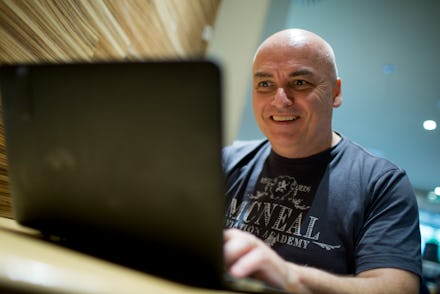A Shocking Number of People Are Still Paying for AOL Dial-up

On Tuesday morning, Verizon announced its plans to acquire AOL for $4.4 billion in cash. The deal generated its fair share of surprise; many wondered why the country's largest wireless service provider was spending the monetary equivalent of nearly four Jay Z and Beyonce empires to take over something most people associate with chatrooms, instant messages and dusty CD-ROMS — in short, the Internet of the 1990s.
Even more surprising than the deal itself, however, is the fact that a huge number of people still subscribe to AOL's dial-up packages: an astounding 2.16 million Americans, paying an average of $20.83 a month — up from $18 just a few years ago. And while AOL's customer base has continued to shrink from the 3.62 million paying Americans it had in 2011, the increasing fees make up for it. The company is making a pretty penny off a subpar service that most people left behind with their Beanie Babies and frosted lipstick.
Re/code's Peter Kafka explored AOL's cash cow in August, coming to the conclusion that the dial-up model works because it traffics in "forgetfulness." AOL customers have simply forgotten (or neglected) to cancel their service.
"I'd like to say I can't believe this is real," Kafka wrote. "But then again, I'm the guy who still pays Netflix for a DVD subscription, and I haven't played a DVD in years."
But that's not why Verizon is interested. Verizon didn't pay $4.4 billion in cash to take over a few hundred million in profit from dial-up customers. Rather, the company is looking closely at AOL's value as an advertising platform, a tool through which they can expand their mobile video reach.
Jim Edwards at Business Insider pointed out these three letters: OTT, or "over-the-top," which broadly refers to television programming distributed on the Web. Edwards explains that although Verizon is a big provider of more traditional TV cable programming, that industry is slowly dying — and Internet and mobile video is taking its place.
Edwards concludes:
AOL has owns a lot of content brands, like Techcrunch and Huffington Post, that publish a lot of video. AOL CEO Tim Armstrong has for years been pursuing the idea that he might somehow turn AOL into a sort of Internet-based cable TV competitor.
In a letter detailing the move to AOL employees, CEO Tim Armstrong emphasized the importance of mobile. "If there is one key to our journey to building the largest digital media platform in the world, it is mobile," he said in the letter, which Business Insider obtained. "Mobile will represent 80% of consumers' media consumption in the coming years, and if we are going to lead, we need to lead in mobile."
The acquisition is the beginning of a partnership. "The visions of Verizon and AOL are shared," Armstrong told the New York Times. "The companies have existing successful partnerships, and we are excited to work with the team at Verizon to create the next generation of media through mobile and video."
Of course, given the huge cash deal, Verizon's interests lie in revenue.
"At Verizon, we've been strategically investing in emerging technology, including Verizon Digital Media Services and O.T.T., that taps into the market shift to digital content and advertising. AOL's advertising model aligns with this approach, and the advertising platform provides a key tool for us to develop future revenue streams," Verizon CEO Lowell C. McAdam said in a statement, according to the New York Times.
While the full consequences of the deal are still unknown — particularly when it comes to net neutrality and AOL's tech-news sites that are now owned by a corporate tech giant — the digital media and advertising landscape will certainly shift. That is, if it hasn't already.